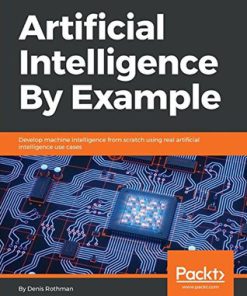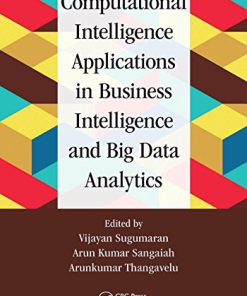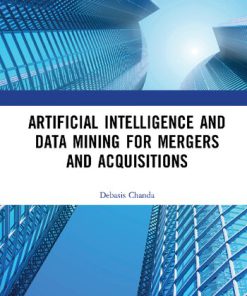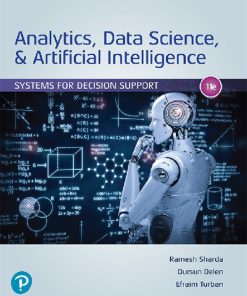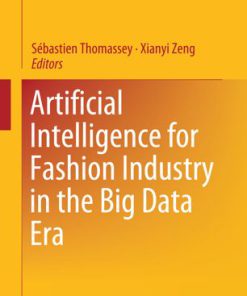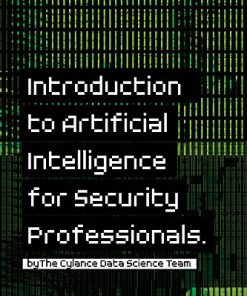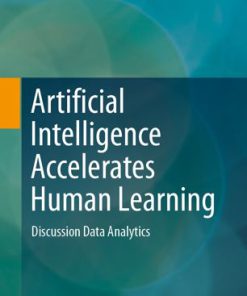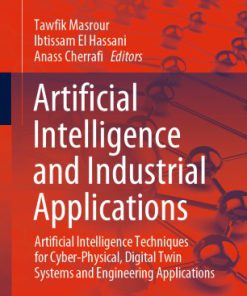Artificial Intelligence for Big Data Complete guide to automating Big Data solutions using Artificial Intelligence technique 1st edition by Anand Deshpande,Manish Kumar 9781788472173 1788472179
$50.00 Original price was: $50.00.$25.00Current price is: $25.00.
Artificial Intelligence for Big Data Complete guide to automating Big Data solutions using Artificial Intelligence technique 1st edition by Anand Deshpande,Manish Kumar- Ebook PDF Instant Download/Delivery:9781788472173,1788472179
Full download Artificial Intelligence for Big Data Complete guide to automating Big Data solutions using Artificial Intelligence technique 1st edition after payment
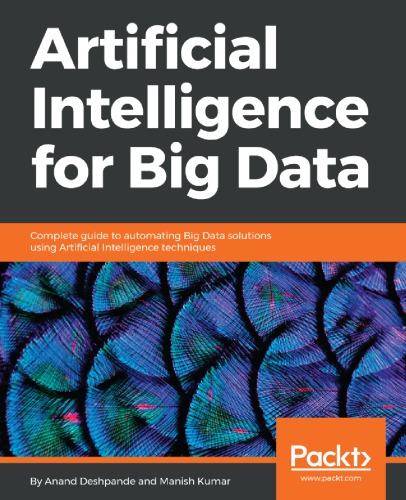
Product details:
ISBN 10:1788472179
ISBN 13:9781788472173
Author:Anand Deshpande,Manish Kumar
Key Features
- Implement Artificial Intelligence techniques to build smart applications using Deeplearning4j a Java deep learning library
- Create smart self learning and decision making systems
- Develop smarter Big data applications to get better insights from your analysis
Book Description
In the age of big data, companies have growing amount of consumer data than ever before – far more than human and their current technologies can ever hope to keep up with. Artificial Intelligence closes the gap by moving far past human limitations to consume and analyze data.
This book will help you create smart systems to extract intelligent insights for decision making. We will learn about widely used Artificial Intelligence techniques for carrying out solutions in a production ready environment. Explore advanced topics like neural network, clustering, symbolic and sub-symbolic information representation and many more.
Later we will use machine learning algorithms such as K-means, SVM, RBF, regression to perform advance data analysis. We will take you through an understanding of the current status of Machine and Deep Learning techniques to Genetic and Neuro-Fuzzy algorithms. This book aims to address how to develop Artificial Intelligence algorithms to learn from data, why they are necessary, and how they can help to solve real world problems.
By the end of this book, you’ll learn how to implement various Artificial Intelligence algorithms for your big data systems and integrate into your product offerings such as search, image recognition and language processing, Genetic Algorithms, and Fuzzy Logic systems
What you will learn
- Manage Artificial Intelligence techniques for Big Data with Java.
- Build smart systems that can analyze vast and growing data to apply the results for enhanced customer experiences
- Learn to use Artificial Intelligence Frameworks for Big Data.
- Understand and manage complex problems with Genetic Algorithms and Neuro-Fuzzy Systems
- Design an approach to leverage data using the steps in the machine learning process.
- Apply deep learning techniques to explore and prepare data for modeling.
- Construct models that learn from data using widely available open source tools
- Analyze big data problems using scalable machine learning algorithms on Spark.
Artificial Intelligence for Big Data Complete guide to automating Big Data solutions using Artificial Intelligence technique 1st Table of contents:
Who this book is for
What this book covers
To get the most out of this book
Download the example code files
Download the color images
Conventions used
Get in touch
Reviews
Big Data and Artificial Intelligence Systems
Results pyramid
What the human brain does best
Sensory input
Storage
Processing power
Low energy consumption
What the electronic brain does best
Speed information storage
Processing by brute force
Best of both worlds
Big Data
Evolution from dumb to intelligent machines
Intelligence
Types of intelligence
Intelligence tasks classification
Big data frameworks
Batch processing
Real-time processing
Intelligent applications with Big Data
Areas of AI
Frequently asked questions
Summary
Ontology for Big Data
Human brain and Ontology
Ontology of information science
Ontology properties
Advantages of Ontologies
Components of Ontologies
The role Ontology plays in Big Data
Ontology alignment
Goals of Ontology in big data
Challenges with Ontology in Big Data
RDF—the universal data format
RDF containers
RDF classes
RDF properties
RDF attributes
Using OWL, the Web Ontology Language
SPARQL query language
Generic structure of an SPARQL query
Additional SPARQL features
Building intelligent machines with Ontologies
Ontology learning
Ontology learning process
Frequently asked questions
Summary
Learning from Big Data
Supervised and unsupervised machine learning
The Spark programming model
The Spark MLlib library
The transformer function
The estimator algorithm
Pipeline
Regression analysis
Linear regression
Least square method
Generalized linear model
Logistic regression classification technique
Logistic regression with Spark
Polynomial regression
Stepwise regression
Forward selection
Backward elimination
Ridge regression
LASSO regression
Data clustering
The K-means algorithm
K-means implementation with Spark ML
Data dimensionality reduction
Singular value decomposition
Matrix theory and linear algebra overview
The important properties of singular value decomposition
SVD with Spark ML
The principal component analysis method
The PCA algorithm using SVD
Implementing SVD with Spark ML
Content-based recommendation systems
Frequently asked questions
Summary
Neural Network for Big Data
Fundamentals of neural networks and artificial neural networks
Perceptron and linear models
Component notations of the neural network
Mathematical representation of the simple perceptron model
Activation functions
Sigmoid function
Tanh function
ReLu
Nonlinearities model
Feed-forward neural networks
Gradient descent and backpropagation
Gradient descent pseudocode
Backpropagation model
Overfitting
Recurrent neural networks
The need for RNNs
Structure of an RNN
Training an RNN
Frequently asked questions
Summary
Deep Big Data Analytics
Deep learning basics and the building blocks
Gradient-based learning
Backpropagation
Non-linearities
Dropout
Building data preparation pipelines
Practical approach to implementing neural net architectures
Hyperparameter tuning
Learning rate
Number of training iterations
Number of hidden units
Number of epochs
Experimenting with hyperparameters with Deeplearning4j
Distributed computing
Distributed deep learning
DL4J and Spark
API overview
TensorFlow
Keras
Frequently asked questions
Summary
Natural Language Processing
Natural language processing basics
Text preprocessing
Removing stop words
Stemming
Porter stemming
Snowball stemming
Lancaster stemming
Lovins stemming
Dawson stemming
Lemmatization
N-grams
Feature extraction
One hot encoding
TF-IDF
CountVectorizer
Word2Vec
CBOW
Skip-Gram model
Applying NLP techniques
Text classification
Introduction to Naive Bayes’ algorithm
Random Forest
Naive Bayes’ text classification code example
Implementing sentiment analysis
Frequently asked questions
Summary
Fuzzy Systems
Fuzzy logic fundamentals
Fuzzy sets and membership functions
Attributes and notations of crisp sets
Operations on crisp sets
Properties of crisp sets
Fuzzification
Defuzzification
Defuzzification methods
Fuzzy inference
ANFIS network
Adaptive network
ANFIS architecture and hybrid learning algorithm
Fuzzy C-means clustering
NEFCLASS
Frequently asked questions
Summary
Genetic Programming
Genetic algorithms structure
KEEL framework
Encog machine learning framework
Encog development environment setup
Encog API structure
Introduction to the Weka framework
Weka Explorer features
Preprocess
Classify
Attribute search with genetic algorithms in Weka
Frequently asked questions
Summary
Swarm Intelligence
Swarm intelligence
Self-organization
Stigmergy
Division of labor
Advantages of collective intelligent systems
Design principles for developing SI systems
The particle swarm optimization model
PSO implementation considerations
Ant colony optimization model
MASON Library
MASON Layered Architecture
Opt4J library
Applications in big data analytics
Handling dynamical data
Multi-objective optimization
Frequently asked questions
Summary
Reinforcement Learning
Reinforcement learning algorithms concept
Reinforcement learning techniques
Markov decision processes
Dynamic programming and reinforcement learning
Learning in a deterministic environment with policy iteration
Q-Learning
SARSA learning
Deep reinforcement learning
Frequently asked questions
Summary
Cyber Security
Big Data for critical infrastructure protection
Data collection and analysis
Anomaly detection
Corrective and preventive actions
Conceptual Data Flow
Components overview
Hadoop Distributed File System
NoSQL databases
MapReduce
Apache Pig
Hive
Understanding stream processing
Stream processing semantics
Spark Streaming
Kafka
Cyber security attack types
Phishing
Lateral movement
Injection attacks
AI-based defense
Understanding SIEM
Visualization attributes and features
Splunk
Splunk Enterprise Security
Splunk Light
ArcSight ESM
Frequently asked questions
Summary
Cognitive Computing
Cognitive science
Cognitive Systems
A brief history of Cognitive Systems
Goals of Cognitive Systems
Cognitive Systems enablers
Application in Big Data analytics
Cognitive intelligence as a service
IBM cognitive toolkit based on Watson
Watson-based cognitive apps
Developing with Watson
Setting up the prerequisites
Developing a language translator application in Java
Frequently asked questions
Summary
People also search for Artificial Intelligence for Big Data Complete guide to automating Big Data solutions using Artificial Intelligence technique 1st:
artificial intelligence for fashion industry in the big data era
big data and artificial intelligence new challenges for workplace equality
artificial intelligence vs big data analytics
big data and artificial intelligence modeling for drug discovery
understanding how artificial intelligence big data and collaborative computing
Tags:
Anand Deshpande,Manish Kumar,Intelligence,Artificial
You may also like…
Computers - Computer Science
Business & Economics - Management & Leadership
Computers - Computer Science
Artificial Intelligence and Data Mining for Mergers and Acquisitions 1st Edition Debasis Chanda
Business & Economics - Management & Leadership
Computers - Computer Science
Business & Economics - Sales & Marketing
Artificial Intelligence for Fashion Industry in the Big Data Era Sébastien Thomassey
Computers - Computer Science
Artificial Intelligence Accelerates Human Learning Discussion Data Analytics Katashi Nagao
Computers - Computer Science




